This is the Sponsored paywall logged out

Effective management of network risks arising from vegetation requires a sophisticated pipeline of data capture and interrogation. Tim Hustwayte, Senior Client Manager at NM Group, explains how.
The ongoing management of trees around powerlines is a multi-billion annual activity worldwide. The implications of getting it wrong run into further billions: from the economic impact of network outages through to asset damage following natural disasters.
Through many hundreds of collective conversations with the operational and management teams at transmission and distribution networks, we think we can summarise the common problem: “we want to reduce the risk to the network and the public while ideally spending the same or less”.
So how to manage trees more cheaply without exposing the network to greater risk? It can be tempting to find incremental gains at the expense of arborists margins, however this is limited and potentially damaging to network resilience. It is our view that to fully address the problem it will require a change in mindset and the ability to do things smarter – standing back and letting data science do the hard work.
What we have come to believe is that networks don’t actually have a tree problem, they have a data problem. Effective actions in the field come from good planning. Optimal planning can only occur if companies are furnished with the best information.
Of course, this information relies on quality data paired with effective analysis. The whole process relies on good data passing through the entire work cycle, from field inspection, analysis, planning, field execution and reporting.
Transferring data from stage to stage is nearly always inefficient, inaccurate or even impossible and therein lies an opportunity for networks to save money, reduce vegetation risk or more often – to achieve both.
How then can this goal be achieved? Our premise is that you need to look at UVM holistically and from the perspective of a data and information pipeline if you want to address that fundamental problem. We believe that utilities in the future will be collecting even more data via a variety of means, suppliers and technologies. So being able to manage and harness this effectively is going to be a crucial aspect of success.
It’s easy to list buzzwords and leave it there – but we know that we need to relate this to poles, towers, spans and trees.
This means the creation of a digital twin and robust data model that can be analysed, understood and actioned, within the data pipeline. With the digital twin complete, a utility will want the ability to interrogate this virtual world, making sense of the various inputs to drive the best decision making.
What could that mean? Well for starters think weather forecasts influencing real-time tree risk, vegetation growth speeds for optimum tree management and real-time field team location to best optimise time on site… you get the idea.
Crucially, there needs to be analytics and smart so. Ware that present this in a way that can be easily digested – providing the tools for the utility to test different scenarios and be confident that the decision they are making is the very best one for the organisation.
In our conversations with customers, we find it useful to talk in terms of the UVM cycle and data flows. I recommend you do the same. Look for areas where there are gaps and think about how technology and so. ware can be applied. By maintaining this higher-level view, you can focus on achieving maximum benefit and move towards that ever-elusive goal of ‘less risk, less spend’.
For more information, go to NM Group





Please login or Register to leave a comment.